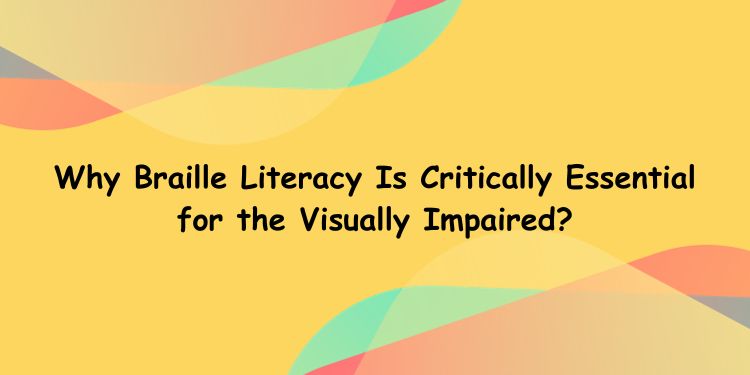Braille literacy holds profound significance for individuals with visual impairments, offering them access to education, information, and employment opportunities.
This blog delves into the crucial role of braille in the lives of the visually impaired, shedding light on its impact on academic achievement, social inclusion, and overall quality of life.
What is Braille Literacy?
Braille, a tactile writing system that was developed by Louis Braille in the 19th century. It is a combination of 6 raised dots which makes letters of the alphabet, punctuation, numbers even music notations etc. that are read with touch by people who are usually impaired.
Braille is the system that helps the visually impaired read, write and understand the written word. This ingenious method has been a hope for the visually impaired offering them a way to access information education and employment opportunities.
Empowering Social Inclusion
Braille literacy is not just about reading and writing; it’s about empowering individuals with visual impairments to be active participants in society. When someone learns Braille, they gain the ability to independently access information.
Social inclusion for visually impaired individuals means ensuring that they get equal access, rights and opportunities concerning education, jobs, healthcare, and legal work.
This means they can read books, menus, labels, and even digital screens with Braille displays. It’s a crucial step towards breaking down the barriers that can isolate visually impaired individuals from the rest of the world.
Bridging the Educational Gap
For visually impaired students, Braille literacy is a game-changer. It ensures they have equal access to education.
Visually Impaired students should be able to access information in various ways for example audio content, and large prints. Schools need to provide information with alternative formats and they should give the visually impaired the material, and wait for them to complete tasks, learn, and keep notes.
Without Braille, these students might struggle to keep up with their sighted peers. With Braille, they can read textbooks, take notes, and complete assignments, levelling the playing field and enabling them to reach their full academic potential.
Vital for Job Opportunities
For the visually impaired getting a job can be a challenge if there is not enough support from society. For a long time, the unemployment rate among people with visual disabilities has been over 70% and still, in many parts of the world, visually impaired individuals are still not getting equal opportunities.
Braille literacy opens up the world of employment for visually impaired individuals. It allows them to apply for jobs, read job-related materials, and communicate effectively in the workplace.
In fact, studies have shown that Braille literacy significantly improves employment outcomes for the visually impaired.
Fostering Independence and Confidence
Being able to read, and write independently is not just a skill but your key to independence. It boosts the confidence and self-esteem of individuals and allows them to choose their careers and jobs.
Braille literacy gives them the freedom to explore the world, express their thoughts in writing or navigate daily lives with greater independence.
Overcoming Technological Challenges
In today’s digital age, technology plays a crucial role in our lives. Braille literacy is not at odds with technology; it complements it.
Braille displays and Braille-compatible devices allow visually impaired individuals to interact with computers, tablets, and smartphones.
This integration of Braille with technology enhances their ability to communicate, access information, and stay connected in an increasingly digital world.
The urgent need for Braille Literacy
Despite the immense benefits of Braille literacy, there is still a significant gap in its accessibility, particularly in countries like India where the Braille literacy rate is shockingly low at just 1%. It’s imperative that we work towards increasing access to Braille education for visually impaired individuals worldwide.
Final Thoughts
Braille literacy is not just about reading and writing; it’s about empowering visually impaired individuals to live full, independent lives. It’s a bridge to education, employment, and social inclusion. As a society, we must recognize the critical importance of Braille literacy and take steps to ensure it is accessible to all who need it. Together, we can open up a world of possibilities for the visually impaired. Explore our website and connect with our expert Braille transcription services. Experience the joy of reading in Braille today!







